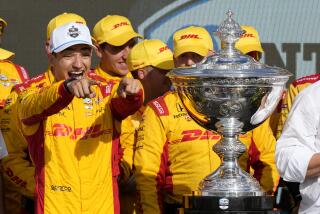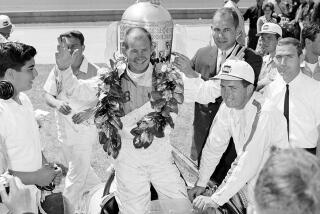Setback Doesn’t Stall Brabham : Passed Over by One Team, He’s Still Chasing Indy Car Win
Geoff Brabham, who says his long-term goal is to win the Indianapolis 500, had a chance to come closer a couple of weeks ago.
Bobby Rahal announced that he was leaving the Truesports team, and Brabham was one of two drivers under consideration for the position that Rahal rode to victory in 1986 and to CART Indy car national championships in ’86 and ’87.
It seemed like a good match. Brabham, 36, had driven in 85 Indy car races, including seven Indy 500s, and was known as a fast, smart, clean driver who always brought the car back with all the wheels and bodywork attached. His father, Jack, revolutionized the sport when he brought a rear-engine race car to Indianapolis in 1961.
Instead, the ride went to Scott Pruett, a bright star emerging from the International Motor Sports Assn. road-racing ranks but, nevertheless, a rookie.
The decision apparently hinged on the fact that Pruett is from Roseville, Calif., a suburb of Sacramento, and Brabham is from Sydney, Australia, where they drink a different brand of beer. Truesports boss Steve Horne favored Brabham, but Truesports’ major sponsor, Budweiser, demonstrated how money talks.
Truesports and Budweiser figure to visit a lot of winner’s circles with Pruett, but Brabham said: “As far as I was concerned, Steve Horne wanted me to drive the car, and we just couldn’t put it together with the sponsors.
“Steve and I have known each other for a long time. We won the Can Am championship together in 1981. It was an opportunity to get back together, but Budweiser, basically, wanted an American driver. That’s what it came down to.”
Brabham’s disappointment didn’t keep him from winning the IMSA Grand Touring Prototype race at Columbus, Ohio, that weekend--his 9th victory in 11 races this year, clinching the championship.
“That other thing was totally out of my control,” he said later. “I’ll carry on with life.
“I came close. It didn’t work out. I have some possibilities for next year to do Indianapolis and maybe some other races. There are some people interested.”
Brabham, driving the Nissan GTP ZX-Turbo, will press on this weekend in the Camel Grand Prix event at Del Mar, which wraps up the Camel GTP season. With the title in his pocket, he has two other incentives: the manufacturers’ championship for Nissan and $140,000 for the winning car, richest purse ever in IMSA racing.
Anyone who failed to notice that Brabham won the title and was honored by the racing media as the top race driver for the third quarter of the year, after Indy 500 winner Rick Mears and NASCAR’s Dale Earnhardt, can grasp the difference between IMSA and Indy car racing.
In the 22 years of the award, no other IMSA driver was so recognized.
“But it took an 8-straight win streak to do it,” Brabham said.
Brabham is a realist. He understands that one Indy 500 win would be worth more than everything else he has done in racing. Even a single CART win in an Indy car would earn him some notoriety.
But all he has are six second-place finishes, four thirds and some fourths and fifths, and the best he ever finished in the big one was fourth in 1983, nursing the UNO-British Sterling machine around the brickyard. His Indy experience consists mostly of worrying not where he’ll finish, but whether he’ll finish.
With nothing to do last week while the Indy car drivers were preparing to race at Laguna Seca, Brabham discussed career breaks.
“I’ve driven for some teams that are very good now, but when I was driving for them, they weren’t nearly as good and weren’t in a position where I could go out and test,” he said. “I never had any sponsorship behind me, so I could go where I wanted to go. I had to take some drives that I knew had no chance of winning, but I had to do something.”
What will it take to get him that elusive winning Indy car ride?
“Being in the right place at the right time,” Brabham said. “Being able to win some races. Unfortunately, that was the biggest thing that went against me until now. I’ve never been able to win a race.”
But Brabham this year proved that he could win in a good car. Funny thing about that car.
“I feel like I’m driving the only successful all-American-built car running in competitive racing now, outside of NASCAR,” he said. “The aerodynamics and all the bodywork is built here in Southern California.”
Also, the mechanical components were designed by Don Devendorf at Electramotive Engineering in El Segundo. About the only Japanese thing on it is the decal: Nissan.
Even the rival Corvettes, Brabham pointed out, “run a Lola chassis that’s built in England.”
So if Nissan is willing to entrust its all-American car to Brabham, why can’t he get an Indy car?
Brabham feels he’s just fighting the system and, perhaps, a reputation that he’s not aggressive enough to win. He indicated that it’s true that he doesn’t believe in taking any more risks than necessary when he reflected on the death of Al Holbert, IMSA’s all-time winner, who crashed his private plane at Columbus 2 days before that race.
“I consider myself a pretty conservative person outside of race cars,” Brabham said. “I do not like flying. I’m a nervous flyer. Most race drivers, we go to the limits while we’re driving a race car. That satisfies me. I don’t need to go and do other things to get a thrill.
“My dad used to love flying his own plane, and I used to go with him, but there’s no interest for me to do that now.”
One gets the impression that Brabham wouldn’t have enjoyed driving in his father’s era.
“The big thing now is that cars don’t catch fire anymore,” he said. “Races back then must have been really scary. Now we can run 220 m.p.h. and feel fairly safe.”
Brabham senses that a lot of good drivers died because they tried too hard in bad cars.
“If you’re not quite there, and you’re not driving for a team that can get you there, you can drive your heart out and do all sorts of things and no one’s gonna take any notice of you,” he said.
“It’s easy to say, ‘Oh, he’s just a smooth driver.’ But the guys at the back are running just as hard as the guys up front, with what they’ve got, and it makes no difference.
“This year it’s basically been between me and the Jaguars. Things get pretty aggressive up front. But the guys in the Porsches are trying just as hard. It’s unfair to characterize anybody.
“I believe I can be whatever I want to be. I think I proved that this year. I can be aggressive when the need calls for it. I can try to save the car when that need arises. I don’t think I’m a one-dimensional driver.
“If you characterize being smooth as not crashing a lot, maybe I am smooth. I don’t think I fall off the road that much. But I certainly believe I can roll up my sleeves and fight with the best of ‘em when it’s required.”
More to Read
Go beyond the scoreboard
Get the latest on L.A.'s teams in the daily Sports Report newsletter.
You may occasionally receive promotional content from the Los Angeles Times.










